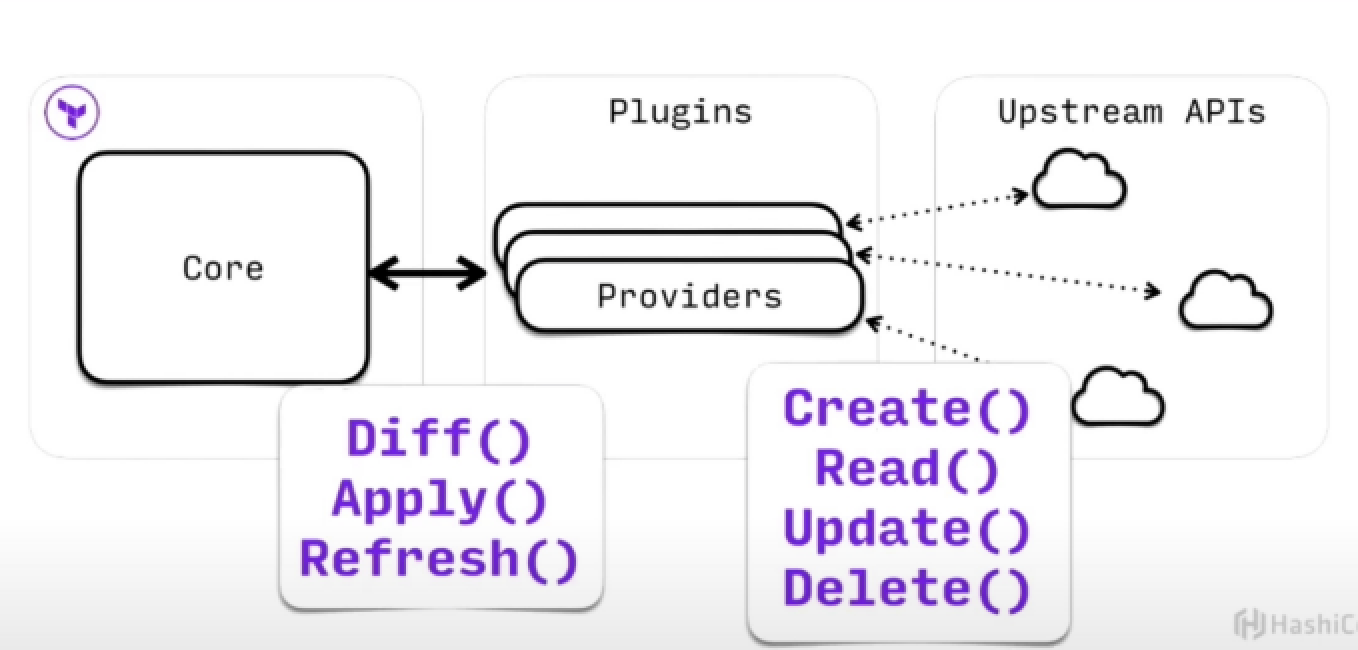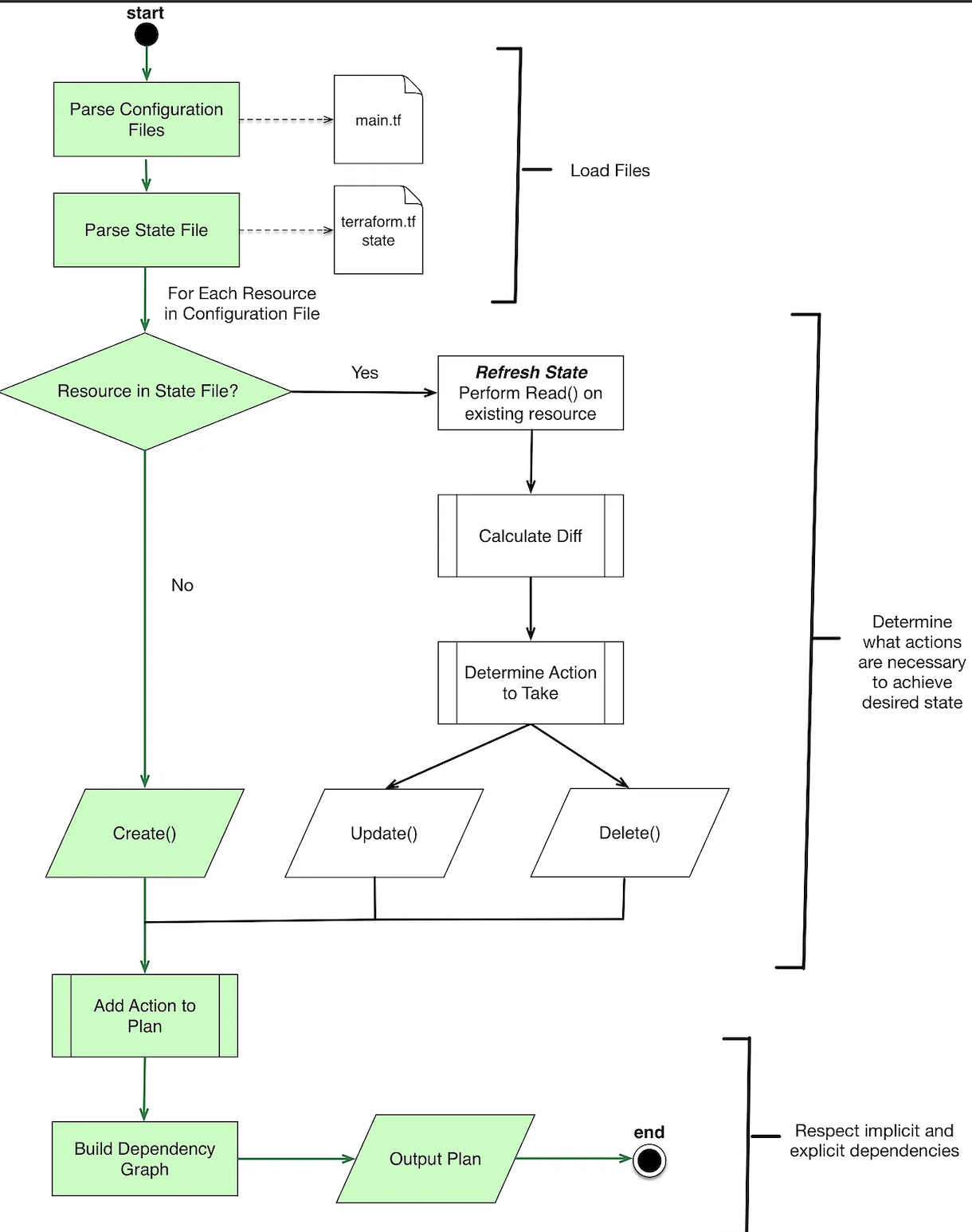data handling and conversion
terraform AWS provider includes: Terrafom plugin and AWS API client
data handling and conversion is needed as one side is IaC tool, anothor side is AWS API details
Expanding: data is converted from a planned new tf state into making a remote system request
Flattening: a remote system response is converted into an applied new tf state
The Terraform AWS Provider codebase bridges the implementation of a Terraform Plugin and an AWS API client to support AWS operations and data types as Terraform Resources. Data handling and conversion is a large portion of resource implementation given the domain-specific implementations of each side of the provider. The first is where Terraform is a generic infrastructure as code tool with a generic data model and the other is where the details are driven by AWS API data modeling concepts.
Terraform Core
- reads HCL or json files; parse them into an internal data structure
- state management; maintains and updates the tf state file(terraform.tfstate), track real-world resources and apply them
- graph construction; builds a dependency graph for all resources, ensure resources are created, updated, or destroyed in the correct order
- execution plan generation; compares desired state with current state, creates execution plan(terraform plan)
- resource application: applies changes and interacts with tf providers
- provider & plugin interation
- change detection and drift management
Terraform Plugins
providers + provisioners
 (°0°)
(°0°)
Core vs Providers
- core
gRPC client(go-plugin)
user facing
manage whole resources graph
manage state and ask providers to update resource state
manage providers operations(CRUD) order - Provider
gRPC server
execute domain-specific logic: CRUD,import,validate a resource; read a data source
provide resource updated state to terraform core
validate domain-specific inputs and handle errors
 (°0°)
(°0°)
Terraform plan execution
 (°0°)
(°0°)
Data handling when creating a tf resoruce
- An operator creates a Terraform configuration with a new resource defined and runs terraform apply
- Terraform CLI merges an empty prior state for the resource, along with the given configuration state, to create a planned new state for the resource
3.Terraform CLI sends a Terraform Plugin Protocol request to create the new resource with its planned new state data
4.If the Terraform Plugin is using a higher-level library, such as the Terraform Plugin Framework, that library receives the request and translates the Terraform Plugin Protocol data types into the expected library types
5.Terraform Plugin invokes the resource creation function with the planned new state data- The planned new state data is converted into a remote system request (e.g., API creation request) that is invoked
- The remote system response is received and the data is converted into an applied new state
6.If the Terraform Plugin is using a higher-level library, such as the Terraform Plugin Framework, that library translates the library types back into Terraform Plugin Protocol data types
7.Terraform Plugin responds to Terraform Plugin Protocol request with the new state data
8.Terraform CLI verifies and stores the new state
DataSource and Resource
Resource: represent a single AWS API object
Data Source: fetch a AWS object data
Terraform schema
refer
Terraform Plugins are expressed using schemas to define attributes and their behaviors, using a high level package exposed by Terraform Core named schema. Providers, Resources, and Provisioners all contains schemas, and Terraform Core uses them to produce plan and apply executions based on the behaviors described.
- Types:
```
“tags”: {
Type: schema.TypeMap,
Elem: &schema.Schema{
Type: schema.TypeString,
},
},
resource “example_compute_instance” “ex” {
tags {
env = “development”
name = “example tag”
}
}
- Behaviors:
“uuid”: {
Type: schema.TypeString,
Computed: true,
},
resource “example_volume” “ex” {
name = “swap volume”
encrypted = true
}
output “volume_uuid” {
value = “${example_volume.ex.uuid}”
}
```
Create resource logic
created schema -> create function(aws sdk api + retry waiter) -> return resource data -> store state